Microfiber Magic How to Eradicate Dirt and Bacteria Effectively
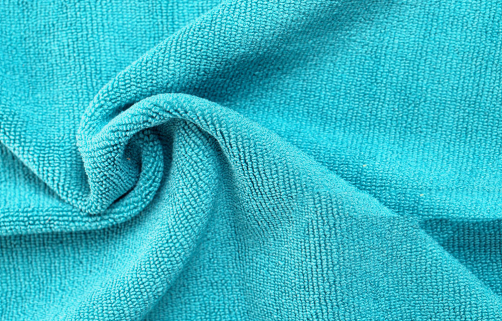
A Microfiber Cleaning Cloth stands as the ultimate solution for removing dirt and bacteria. It achieves superior cleanliness compared to traditional methods. These cloths are indispensable for a truly hygienic environment. Microfiber materials contain synthetic fibers smaller than 1 micrometer, allowing them to penetrate microscopic surface crevices for thorough cleaning.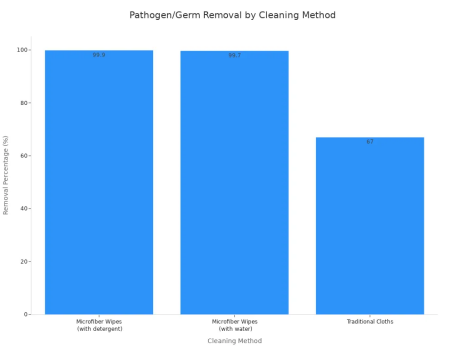
“Using microfiber rags eliminates up to 99 percent of bacteria — about three times the effectiveness of traditional cleaning cloths,” says Peterson. “This is why many hospitals have converted to microfiber cloths, towels and mops.”
Key Takeaways
● Microfiber cloths clean better than cotton. They use tiny fibers and static electricity to trap dirt and germs, removing up to 99% of bacteria.
● Fold your microfiber cloth into quarters. This gives you eight clean sides to use. This method helps you clean more surfaces before needing a new cloth.
● Use different colored microfiber cloths for different areas. This stops germs from spreading. For example, use red for bathrooms and blue for offices.
The Unmatched Power of a Microfiber Cleaning Cloth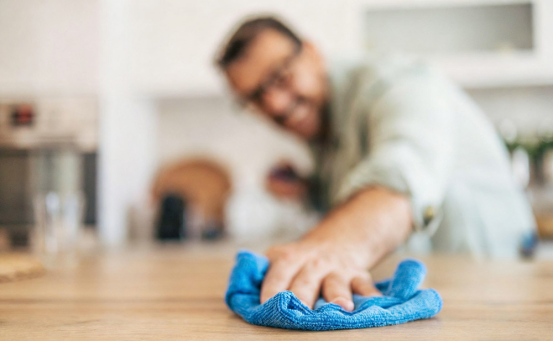
How Microfiber Traps Dirt and Germs
Microfiber's exceptional cleaning ability comes from its unique structure. These synthetic fibers are incredibly fine, much smaller than traditional cleaning materials. Their microscopic size allows them to reach into tiny crevices on surfaces, effectively lifting and trapping dirt particles that larger fibers would miss. The average diameter of these fibers is remarkably small, as shown in the table below:
|
Fiber Type |
Average Diameter (nm) |
|
PU |
420 ± 99.43 |
|
PLLA |
186 ± 65 |
|
PU |
318 ± 102 |
|
PCL |
600–1000 |
This advanced technology involves microscopic fibers. These tiny fibers possess an exceptional ability to trap and hold onto dirt particles. This distinguishes them from traditional cleaning materials. This unique characteristic allows for thorough cleaning. The fibers create a vast surface area with countless tiny hooks and loops. These features physically grab and secure dirt, dust, and even microscopic organisms. A Microfiber Cleaning Cloth does not just push debris around; it captures it.
The Electrostatic Advantage of Microfiber
Beyond its physical structure, microfiber also utilizes an electrostatic advantage. Microfiber generates an electrostatic charge during cleaning because it is made of synthetic fibers. The smaller the fiber, the greater the molecular forces it possesses. When these synthetic fibers are present, they also develop electrostatic charges. These combined electrostatic and molecular charges are highly effective at attracting tiny particles. As the cloth moves across a surface, friction creates this charge. This charge acts like a magnet for small, lightweight particles. Microfiber's electrostatic properties are effective at attracting dust, pollen, and other allergens. This makes a Microfiber Cleaning Cloth particularly effective for dry dusting and removing fine airborne particles.
Why Microfiber Outperforms Cotton for Bacteria Removal
Microfiber significantly outperforms cotton in bacteria removal. This superior performance stems from fundamental structural differences.
● Microfiber: It features incredibly fine fibers, typically smaller than a strand of silk. This fine structure creates a larger surface area. This enhances its ability to pick up, trap, and remove dirt, dust, and bacteria.
● Cotton: It has larger and less dense fibers. This makes cotton less efficient at trapping small particles compared to microfiber.
The tight weave and microscopic fibers of microfiber physically capture bacteria and viruses. Cotton fibers, being larger and more absorbent, tend to spread bacteria rather than remove them. Studies consistently show microfiber's superior efficacy.
|
Material |
Bacteria Removal |
Virus Removal |
|
Microfiber |
Up to 98% |
93% |
|
Cotton |
30% |
23% |
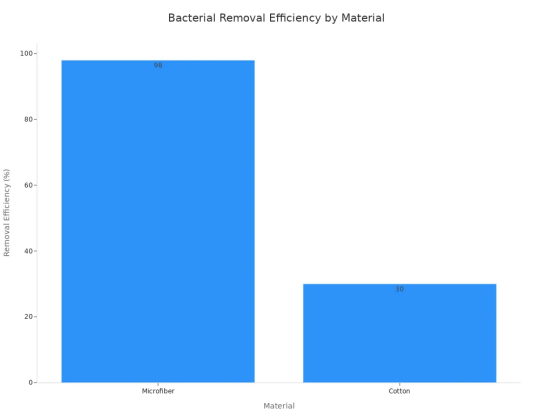
A study found that new microfiber towels showed superior results for surface decontamination. However, cotton towels more effectively removed bacteria from surfaces after reprocessing. The efficacy of microfiber towels was observed to decrease after just 20 washing cycles. This occurred despite manufacturer claims of sustained efficacy for up to 500 washes. This highlights the importance of proper care and replacement for microfiber products. Even with this consideration, microfiber's initial and general performance for bacteria removal remains significantly higher than cotton.
Maximizing Effectiveness with Your Microfiber Cleaning Cloth
Essential Preparation and Folding Techniques
Proper preparation significantly enhances the effectiveness of any cleaning tool. For a microfiber cloth, this begins with a simple yet crucial folding technique. Experts advise against wadding up the towel. Instead, they recommend folding it strategically to maximize its cleaning surface area and efficiency.
Follow these steps for optimal use:
1.Fold the microfiber cloth in half.
2.Fold it in half again. This creates four equal quarters. This method provides access to eight distinct cleaning surfaces.
3.Begin cleaning with one surface. Use this surface until it becomes soiled or damp.
4.Rotate the cloth to a fresh, clean surface once the current one is dirty or wet.
5.Continue rotating and folding the cloth to access new surfaces as each section becomes soiled. This maintains maximum cleaning efficiency without needing a new cloth immediately.
This technique ensures users utilize every part of the cloth before needing a wash. It also prevents spreading dirt from one area to another.
Optimal Cleaning Methods for Various Surfaces
Microfiber cloths adapt to various cleaning tasks across different surfaces. For dry dusting, the cloth's electrostatic properties effectively attract and hold dust, pollen, and pet dander. Simply wipe the dry cloth across surfaces like furniture, electronics, and blinds. The cloth traps particles without releasing them into the air.
For general cleaning, dampen the cloth with water. This method works well for countertops, appliances, and glass. The microscopic fibers, combined with a small amount of water, lift grime and smudges without the need for harsh chemicals. For heavier dirt or sticky residues, a slightly wetter cloth or a small amount of mild cleaner can be used. Always wring out excess water to prevent streaks, especially on shiny surfaces. After cleaning, the surface often dries quickly and streak-free.
Preventing Cross-Contamination with Color-Coded Microfiber
Preventing cross-contamination is critical in maintaining a hygienic environment. Color-coding microfiber cloths offers a simple yet highly effective solution. This system assigns specific colors to different cleaning areas or tasks. This ensures each cloth is used only for its designated purpose. This practice significantly reduces the risk of spreading bacteria or dirt from one zone to another. It is especially vital in environments where cleanliness is paramount, such as hospitals, kitchens, and commercial facilities.
A common color-coding system includes:
● Red: Designated for sanitary appliances, restroom floors, toilets, and urinals.
● Yellow: Used for other restroom surfaces such as sinks, towel dispensers, hand dryers, soap dispensers, door handles, and walls.
● Green: Applied for general food and bar cleanup, including non-preparatory food areas like lunchrooms.
● Blue: Reserved for general low-risk areas, including common areas, offices, and classrooms.
The effectiveness of a color-coding program relies heavily on training and consistency. Staff must understand the "why" behind color coding. This knowledge helps prevent germ spread and ensures the system's success. Maintaining a standardized system helps janitorial and EVS teams minimize accidental bacterial spread between different zones.
Caring for Your Microfiber Cleaning Cloth and Addressing Limitations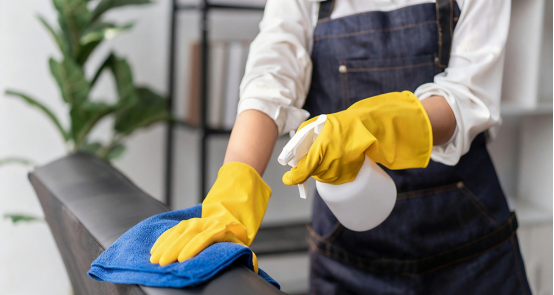
Proper Washing and Disinfection for Longevity
Maintaining microfiber cloths requires specific care to ensure their effectiveness and extend their lifespan. Proper washing prevents damage to the delicate fibers. For washing, users should select a gentle or delicate cycle. Cold water works well for lightly soiled items, while warm water is suitable for heavily soiled cloths. Detergent choice is also crucial. It is best to use detergents free of dyes, perfumes, parabens, and preservatives. Examples include ARM & HAMMER™ Free & Clear Liquid Laundry Detergent or ARM & HAMMER™ Clean & Simple Liquid Laundry Detergent. Mild, liquid detergents specifically designed for microfiber care, such as Chemical Guys EcoSmart-RU01, also preserve integrity.
When a Microfiber Cleaning Cloth Needs Additional Support
While microfiber excels at removing contaminants, certain situations require additional disinfection. Combining detergent/disinfectant with microfiber material offers better control of microbial contaminants on surfaces. For specific pathogens like spore-forming bacteria, sporicidal disinfectants are necessary, especially in contact isolation rooms. Disinfecting cloths weekly, or after cleaning high-risk areas like restrooms or healthcare settings, helps kill nearly all pathogens. This includes bacteria and viruses. UV-C treatment after using a water-dampened microfiber cloth shows promise for Staphylococcus aureus ST5, but further testing is needed for other vegetative, spore-forming, and fungal pathogens.
Understanding Microfiber's Role in Specific Germ Challenges
Microfiber cloths play a significant role in infection control. They effectively reduce germs and prevent cross-contamination. Studies show microfiber mops remove more germs from a surface without disinfectant than cotton mops used with disinfectant. This makes them valuable for general cleaning, even during pandemics. Healthcare settings favor microfiber cloths and mop heads over cotton due to their superior capacity to absorb dirt and microorganisms. Disposable microfiber cloths and mops further enhance infection control. They are used once per surface or room and then discarded. This eliminates the risk of spreading bacteria between patient areas. Modern microfiber is an essential tool in infection control programs.
Microfiber technology consistently delivers superior dirt and bacteria removal. Proper usage and diligent care ensure its sustained effectiveness. Individuals can achieve a healthier, cleaner environment by embracing microfiber. This creates a truly hygienic space for everyone.
FAQ
Can microfiber cloths be used dry?
Yes, microfiber cloths are highly effective for dry dusting. Their electrostatic charge attracts and traps dust, pollen, and pet dander without releasing them into the air.
How often should one wash microfiber cloths?
Wash microfiber cloths after each use, especially when cleaning high-risk areas. Regular washing maintains their effectiveness and prevents germ spread.
Is microfiber safe for all surfaces?
Microfiber is generally safe for most surfaces. However, avoid using it on delicate, unfinished wood or screens with special coatings, as it can sometimes be too abrasive.
